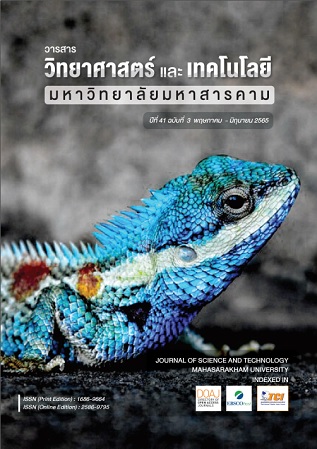Human Detection System with Laser Pointer by Deep Leaning
Main Article Content
Abstract
This research proposes the method for developing an automated person tracking system. At present, many object inspection systems using deep learning. At present, deep learning methods are widely used for object detection methods. An object tracking in a video image is another example. An object tracking in a video image is another example. In this research, the new approach is developed to track and identify people by using deep learning. This method consists of two steps. The first step, deep learning is used to examine the people inside the digital images. The center point of the detected objects is used for the next step. In the last step, two-stepping motors are forced to moving on the vertical and horizontal axes. The moving distance of the two axes is calculated by using the previous step center point. This movement of stepping motors will control the laser pointer for pointing the appeared person in the digital image. The experiment and result demonstrate the best performance of this method. This method can point to the person within the image.
Article Details
References
Chinpanthana, N. (2010). Automatic Counting Objects System by using Template Matching with Normalized Correlation. Dhurakij Pundit University. Retrieved from http://libdoc.dpu.ac.th/research/138607.pdf
Chinpanthana, N., & Phiasai, T. (2017). Fast Normalized Cross Correlationfor Real Time Automatic Counting. RMUTT Journal. Retrieved from http://www.sci.rmutt.ac.th/stj/index.php/stj/article/view/243/189
Girshick, R. (2015). Fast R-CNN.
Goodfellow, I., Bengio, Y., & Courville, A. (2016). Deep Learning. MIT Press.
Hongboonmee, N., & Jantawong, N. (2020). Apply of Deep Learning Techniques to Measure the SweetnessLevel of Watermelon via Smartphone. Journal of Information Science and Technology, 10, 59–69. Retrieved from https://ph02.tci-thaijo.org/index.php/JIST/article/download/240500/163974/
Howard, A. G., Zhu, M., Chen, B., Kalenichenko, D., Wang, W., Weyand, T., Andreetto, M., et al. (2017). MobileNets: Efficient Convolutional Neural Networks for Mobile Vision Applications.
Inthanon, P., & Mungsing, S. (2020). The Ability Test of Model the Facial Landmark Detecting. PKRU SciTech Journal, 4. Retrieved from https://ph01.tci-thaijo.org/index.php/pkruscitech/article/download/240864/165536
Kajornrit, J., Chaipornkaew, P., & Chuan, N. T. M. (2017). An Application of Internet of Things Technology to Control theIllumination Systems in Smart Home. JOURNAL OF INFORMATION SCIENCE AND TECHNOLOGY, 7.
Liu, W., Anguelov, D., Erhan, D., Szegedy, C., Reed, S., Fu, C.-Y., & Berg, A. C. (2016). SSD: Single Shot MultiBox Detector. Lecture Notes in Computer Science, 21–37. doi:10.1007/978-3-319-46448-0_2
Manokij, F. (2019). Thailand’s Precipitation Forecasting Using Deep Learning Approach. Chulalongkorn University. Retrieved from http://cuir.car.chula.ac.th/handle/123456789/65135
Paszke, A., Gross, S., Massa, F., Lerer, A., Bradbury, J., Chanan, G., Killeen, T., et al. (2019). PyTorch: An Imperative Style, High-Performance Deep Learning Library. Advances in Neural Information Processing Systems 32 (pp. 8024–8035). Curran Associates, Inc. Retrieved from http://papers.neurips.cc/paper/9015-pytorch-an-imperative-style-high-performance-deep-learning-library.pdf
Pohtongkam, S., & Srinonchat, J. (2018). Object Recognition for Humanoid Robot using Tactile image processing andArtificial Neural Network. Naresuan University Engineering Journal. Retrieved from https://ph01.tci-thaijo.org/index.php/nuej/article/view/100438/114975
Sandler, M., Howard, A., Zhu, M., Zhmoginov, A., & Chen, L.-C. (2019). MobileNetV2: Inverted Residuals and Linear Bottlenecks.
Saraphak, W., & Thaweewannakij, P. (2018). Real Time GPS Application with Track Team Location. Journal of Project in Computer Science and Information Technology, 4. Retrieved from https://ph02.tci-thaijo.org/index.php/project-journal/article/download/153087/111611/
Szegedy, C., Vanhoucke, V., Ioffe, S., Shlens, J., & Wojna, Z. (2015). Rethinking the Inception Architecture for Computer Vision.
Wongta, P. (2017). Vsion-Based Bus Route Number Reader. Chulalongkorn University. Retrieved from http://doi.org/10.14457/CU.the.2017.574
Yongying, N. (2019). A Deep Learning Approach on Road Detection from Unmanned AerialVehicle-Based Images in Rural Road Monitoring. Naresuan University. Retrieved from http://www.agi.nu.ac.th/nred/Document/is-PDF/2562/geo_2562_05_FullPaper.pdf


